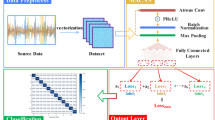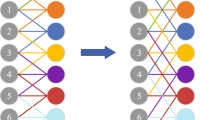Abstract
Due to the complicacy of mechanical instruments and the noise interference in the working environment, the equipment status information contained in a single sensor is insufficient, and multi-source information contains more complete status information. In order to effectively fuse multi-sensor information and improve the reliability of diagnosis, a multi-level fusion dual convolution neural network (MFDCNN) for fault diagnosis of rotating machinery is proposed in this paper. This approach realizes multi-level fusion of fault information by utilizing the flexibility of the structure of the convolutional neural network. During the training process, the two subnets automatically extract representative features from the multi-sensor timedomain signal and its frequency spectrum in parallel, and then fuse the extracted features for pattern recognition to achieve end-to-end fault diagnosis. Compared with the single sensor diagnosis method and single level information fusion method, this approach has better diagnosis performance.
Similar content being viewed by others
References
H. D. Shao, J. S. Cheng, H. K. Jiang, Y. Yang and Z. T. Wu, Enhanced deep gated recurrent unit and complex wavelet packet energy moment entropy for early fault prognosis of bearing, Knowledge-Based Systems, 188 (2019) 105022.
J. H. Yang, D. W. Huang, D. J. Zhou and H. G. Liu, Optimal IMF selection and unknown fault feature extraction for rolling bearings with different defect modes, Measurement, 157 (2020) 107660.
W. Zhang et al., A deep convolutional neural network with new training methods for bearing fault diagnosis under noisy environment and different working load, Mech. Syst. Signal Process., 100 (2018) 439–453.
V. T. Thang, N. A. Tuan and N. V. Tiep, Evaluation of grinding wheel wear in wet profile grinding for the groove of the ball bearing’s inner ring by pneumatic probes, Journal of Mechanical Science and Technology, 32 (3) (2018) 1297–1305.
P. M. Shi et al., A sparse auto-encoder method based on compressed sensing and wavelet packet energy entropy for rolling bearing intelligent fault diagnosis, Journal of Mechanical Science and Technology, 34 (4) (2020) 1445–1458.
D. Y. Han, N. Zhao and P. M. Shi, Gear fault feature extraction and diagnosis method under different load excitation based on EMD, PSO-SVM and fractal box dimension, Journal of Mechanical Science and Technology, 33 (2) (2019) 487–494.
R. N. Liu et al., Artificial intelligence for fault diagnosis of rotating machinery: a review, Mech. Syst. Signal Process., 108 (2018) 33–47.
D. He, R. Y. Li and J. D. Zhu, Plastic bearing fault diagnosis based on a two-step data mining approach, IEEE Trans. Ind. Electron., 60 (8) (2013) 3429–3440.
X. L. Tang, L. Zhuang and J. Cai, Multi-fault classification based on support vector machine trained by chaos particle swarm optimization, Knowl.-Based Syst., 23 (5) (2010) 486–490.
J. Rafiee et al., Intelligent condition monitoring of a gearbox using artificial neural network, Mech. Syst. Sign Process., 21 (4) (2007) 1746–1754.
F. Jia et al., Deep neural networks: a promising tool for fault characteristic mining and intelligent diagnosis of rotating machinery with massive data, Mech. Syst. Signal Process., 72–73 (2016) 303–315.
H. D. Shao et al., Rolling bearing fault feature learning using improved convolutional deep belief network with compressed sensing, Mech. Syst. Signal Process., 100 (2018) 743–765.
Y. G. Lei et al., An intelligent fault diagnosis method using unsupervised feature learning towards mechanical big data, IEEE Trans. Ind. Electron., 63 (2016) 3137–3147.
Y. LeCun, Y. Bengio and G. Hinton, Deep learning, Nature, 521 (7553) (2015) 436–444.
J. Zhu, N. Chen and W. W. Peng, Estimation of bearing remaining useful life based on multiscale convolutional neural network, IEEE Trans. Ind. Electron., 66 (4) (2019) 3208–3216.
L. J. Wang, W. Ouyang and X. G. Wang, Visual tracking with fully convolutional networks, IEEE International Conference on Computer Vision (2015) 3119–3127.
W. Zhang et al., A new deep learning model for fault diagnosis with good anti-noise and domain adaptation ability on raw vibration signals, Sensors, 17 (12) (2017) 425.
O. Janssens et al., Convolutional neural network based fault detection for rotating machinery, J. Sound Vib., 377 (2016) 331–345.
P. Wang et al., Virtualization and deep recognition for system fault classification, J. Manuf. Syst., 44 (2017) 310–316.
G. Q. Jiang et al., Multiscale convolutional neural networks for fault diagnosis of wind turbine gearbox, IEEE Trans. Ind. Electron., 66 (4) (2019) 3196–3207.
J. W. Park, S. H. Sim and H. J. Jung, Displacement estimation using multimetric data fusion, IEEE-ASME Trans. Mechatronics, 18 (6) (2013) 1675–1682.
B. Olofsson et al., Sensor fusion for robotic workspace state estimation, IEEE-ASME Trans. Mechatronics, 21 (5) (2016) 2236–2248.
K. B. Liu, N. Z. Gebraeel and J. J. Shi. A data-level fusion model for developing composite health indices for degradation modeling and prognostic analysis, IEEE Trans. Autom. Sci. Eng., 10 (3) (2013) 652–664.
L. Y. Jing et al., An adaptive multi-sensor data fusion method based on deep convolutional neural networks for fault diagnosis of planetary gearbox, Sensors, 17 (2) (2017) 414.
H. P. Chen et al., A deep convolutional neural network based fusion method of two-direction vibration signal data for health state identification of planetary gearboxes, Measurement, 146 (2019) 268–278.
M. Xia et al., Fault diagnosis for rotating machinery using multiple sensors and convolutional neural networks, IEEE-ASME Trans. Mechatronics, 23 (1) (2018) 101–110.
J. Y. Jiao et al., Deep coupled dense convolutional network with complementary data for intelligent fault diagnosis, IEEE Trans. Ind. Electron, 66 (12) (2019) 9958–9867.
Y. Liu et al., An ensemble convolutional neural networks for bearing fault diagnosis using multi-sensor data, Sensors, 19 (23) (2019) 5300.
G. Hinton et al., Deep neural networks for acoustic modeling in speech recognition: the shared views of four research groups, IEEE Signal Process. Mag., 29 (6) (2012) 82–97.
W. N. Lu et al., Deep model based domain adaptation for fault diagnosis, IEEE Trans. Ind. Electron., 64 (3) (2017) 2296–2305.
H. K. Peng and R. Marculescu, Multi-scale compositionality: Identifying the compositional structures of social dynamics using deep learning, Plos One, 10 (4) (2015) e0118309.
V. Nair and G. E. Hinton, Rectified linear units improve restricted Boltzmann machines, Proceedings of the 27th International Conference on Machine Learning (ICML-10), Haifa, Israel (2010).
D. Scherer, A. Muller and S. Behnke, Evaluation of pooling operations in convolutional architectures for object recognition, 20th International Conference on Artificial Neural Networks, Lecture Notes in Computer Science, 6354 (2010) 92–101.
C. M. Bishop, Pattern Recognition and Machine Learning (Information Science and Statistics), Springer-Verlag, New York (2006).
N. Srivastava et al., Dropout: a simple way to prevent neural networks from overfitting, J. Mach. Learn Res., 15 (2014) 1929–1958.
D. Kingma and J. Ba, Adam: a method for stochastic optimization, Comput. Sci. (2014) arxiv: 1412.6980.
K. Loparo, Seeded Fault Test Data, Case Western Reserve University Bearing Data Centre (2012) (online).
L. van der Maaten and G. Hinton, Visualizing data using t-SNE, J. Mach. Learn Res., 9 (2008) 2579–2605.
Acknowledgments
The studies were funded by the National Natural Science Foundation of China (Grant numbers 51875500 and 61973262), Natural Science Foundation of Hebei Province (Grant number E2020203147), High level talents funding project in Hebei Province (Grant number A201803001) and Project of introducing overseas talents in Hebei Province (C20190516).
Author information
Authors and Affiliations
Corresponding author
Additional information
Dongying Han received Ph.D. degree in Mechanical Design and Theory from Yanshan University, Qinhuangdao, China, in 2008. Now she is a Professor in School of Vehicle and Energy of Yanshan University. Her current research interests include fault diagnosis and signal processing.
Rights and permissions
About this article
Cite this article
Han, D., Tian, J., Xue, P. et al. A novel intelligent fault diagnosis method based on dual convolutional neural network with multi-level information fusion. J Mech Sci Technol 35, 3331–3345 (2021). https://doi.org/10.1007/s12206-021-0707-9
Received:
Revised:
Accepted:
Published:
Issue Date:
DOI: https://doi.org/10.1007/s12206-021-0707-9




